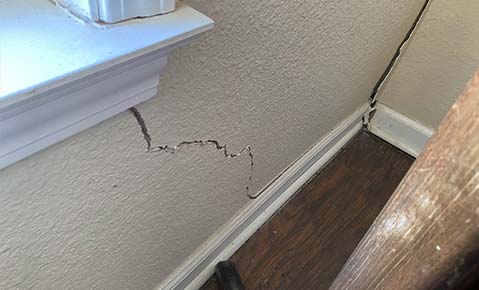Searching for information about residential slope stabilization? If so, you’ve landed on the right page. In this article, we’ll look at the top five residential slope stabilization techniques: vegetation cover, soil nailing, retaining walls, rock bolts, and drainage systems.
What is Slope Stabilization?

Slope stabilization refers to reinforcing a slope or embankment to prevent or mitigate soil erosion, landslides, rockfall, or other slope failures. This is a critical aspect of geotechnical engineering that helps to ensure the safety of people and structures in areas with steep slopes. Slope stabilization techniques involve various methods, including installing retaining walls, soil nails, and rock anchors.
One of the most important factors in slope stability is the angle of repose, the steepest angle at which the slope can remain stable. This angle is influenced by soil type, moisture content, vegetation cover, and underlying geology. Steep slopes with loose or unconsolidated soil, or those disturbed by construction activity, are particularly vulnerable to slope failure.
Why Is Slope Stabilization Sometimes Necessary?
Slope stabilization is sometimes necessary to prevent the occurrence of landslides that may cause damage to people and infrastructure. In many cases, the land’s natural slope may become unstable due to the influence of external factors such as rainfall, erosion, and seismic activity. As a result, the stability of the soil and rock layers may become compromised, leading to the collapse of the slope and the deformation of the landscape.
Slope stabilization can also be necessary from an environmental perspective. When slopes fail or erode, they can cause significant damage to surrounding ecosystems and natural habitats. By stabilizing slopes, experts can help to mitigate such impacts, protecting biodiversity and preserving natural habitats.
Benefits of Residential Slope Stabilization
The two main benefits of residential slope stabilization are increased safety and increased property value:
- Increased safety – Sloped areas can pose a risk of landslides, which can be especially dangerous in residential areas where houses and other structures are often nearby. Implementing slope stabilization measures helps to minimize this risk, making the area safer for residents and minimizing the potential for property damage.
- Increased property value – Sloped areas can be difficult to sell or develop and may even be considered a liability for prospective buyers or investors. Implementing slope stabilization measures demonstrates a commitment to safety and responsible land use, which can make the property more attractive and valuable.
Beyond these benefits, there are additional reasons why homeowners may choose to invest in slope stabilization. For example, it can help reduce soil erosion, protect valuable landscaping, and even improve drainage in the surrounding area.
For more information, see What Is Slope Stabilization?
Top 5 Residential Slope Stabilization Techniques
Vegetation Cover
Using vegetation cover for residential slope stabilization is an environmentally friendly and effective method that has been gaining popularity. This technique involves planting vegetation on the slope to help hold the soil in place and prevent erosion.
Vegetation cover provides several benefits for slope stabilization. The roots of plants help to bind the soil together, making it more resistant to erosion from water and wind. The vegetation cover also helps to absorb rainwater, which reduces the amount of runoff and protects the slope from erosion caused by water. Finally, plants’ leaves and stems help intercept raindrops, which further reduces the force of runoff and erosion.
Vegetation cover can also help beautify the property and increase its aesthetic appeal.
Soil Nailing
Soil nailing involves the installation of steel or fiberglass reinforcing bars (nails) into the soil at a predetermined spacing and depth. The nail heads are then secured into a slope using shotcrete or concrete, which provides a stable surface to support the soil. The method is often combined with other slope stabilization techniques, such as retaining walls and drainage systems.
Retaining Walls
Retaining walls are designed to hold back soil and prevent erosion on sloping ground. Retaining walls are made of different materials, including concrete blocks, rocks, and timber, and they can be built in various styles. The choice of materials and design will depend on the slope gradient, the height of the wall, and the soil conditions.
Like other residential slope stabilization techniques, retaining walls help prevent landslides and soil erosion. Retaining walls are often used to help create more usable space on sloped properties by creating level terraces or garden beds, increasing the property’s aesthetic appeal.
Retaining walls must be designed to withstand the weight of the soil and the pressures exerted by it. Proper drainage is also essential to prevent water build-up behind the wall, which can damage the wall’s stability and cause it to fail.
Rock Bolts
This method of residential slope stabilization involves drilling boreholes into the slope and installing steel rods, otherwise known as rock bolts. The rock bolts run perpendicular to the slope and are anchored into the bedrock underneath. This provides extra support for the slope and prevents it from moving or collapsing.
Drainage Systems
Drainage systems are designed to prevent water from accumulating on slopes, which can cause soil erosion and destabilization. By efficiently removing excess water, these systems can effectively stop soil erosion and improve the overall integrity of the slope.
Two main types of drainage systems are commonly used for residential slope stabilization: surface and subsurface. Surface drainage systems are typically used to remove water from the slope’s surface, while subsurface drainage systems are designed to remove water from below ground, where it can accumulate and cause erosion. Both types of drainage systems can be effective for slope stabilization, depending on the specific characteristics of the slope.
If you have questions about residential slope stabilization, contact us today to schedule an appointment. We serve Southern California, Arizona, and Nevada.







